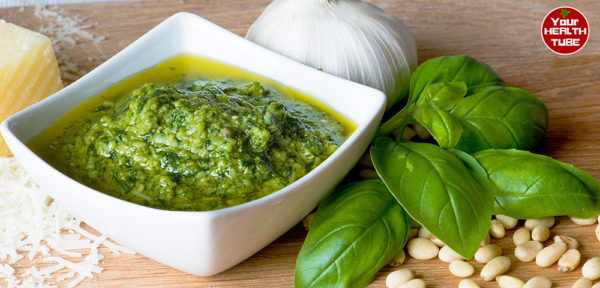Pesto sauce is delicious paste made from basil, pine nuts, garlic, parmesan cheese and olive oil. All of these ingredients have some amazing health benefits, however, there is a huge debate among the experts about this particular food and its potential benefits for our health. So, in this article I would try to give an answer to the most asked question on our blog:
Is it true that we shouldn’t eat pesto sauce because it’s high in fat?
Ingredients such as the pine nuts and olive oil are higher in calories, due to their high fat content. But, what makes pesto sauce considered “healthy” is that the fat in this food is unsaturated.
All of the ingredients in pesto have health benefits and could be included in a well-balanced, healthy diet. When eaten in moderation, unsaturated fat may contribute to an improvement in cholesterol, as well as reduce inflammation in the body. Decreasing inflammation is good because inflammation is linked with a higher risk of cancer, diabetes, Alzheimer’s, heart disease, and many other health ailments associated with aging. Therefore, if you like to include pesto in your diet – you need to eat it in moderation because the calories can add up rapidly.
Pesto Sauce Nutrition Facts
Based on a 2000 calorie diet, ¼ cup serving of pesto sauce contains about:
- 15% DV for Vitamin A
- 6% DV for Vitamin C
- 20% DV for calcium
- 4% DV for iron
DV* – daily value
Vitamin C acts as a powerful antioxidant, vitamin A supports vision health, calcium is vital for strong bones, and iron supports healthy red blood cells. Plus, you can get around 7 grams of protein per serving of pesto. Pesto made from basil also contains numerous flavonoids, potent compounds that help combat disease-causing free radicals and support cell structure.
Calories and Fat
Because of the olive oil, Parmesan cheese, and pine nuts, pesto is relatively calorie dense. Just a 1/4-cup serving provides about 269 calories and 22 grams ‘of fat. However, the fat in pesto sauce is mostly unsaturated that supports heart health. Actually, if you use unsaturated fats rather than saturated fats, you can really experience an improvement in your levels of cholesterol. Replace cream and butter sauces (such as carbonara or Alfredo) with pesto sauce to aid support this switch.
Basil Phytochemicals in Pesto
Basil in pesto adds many phytochemicals to your healthy diet. This incredible herb offers flavonoid phytochemicals, known as vicenin and orientin. These potent phytochemicals act as antioxidants. Vicenin and orientin travel throughout your body and neutralize damaging free radicals, which kill normally healthy cells. These radicals can increase the risk of heart disease, cancer, and many other chronic illnesses. The great amount of basil in your pesto ensures that you get high quantities of these extremely beneficial antioxidants. Find more amazing health benefits of basil:
http://yourhealthtube.com/basil-health-benefits-reasons-herb/
Garlic Effects in Pesto
Garlic in this sauce has numerous important benefits for your well-being. If you have high cholesterol in the blood, consuming garlic can help slightly lower your levels of cholesterol in just 3 months, according to the National Center for Complementary and Alternative Medicine. Garlic can also protect your heart by keeping stable blood pressure levels and reducing the development of atherosclerosis. Even though garlic in pesto can be helpful for these health ailments, you shouldn’t rely solely on garlic to heal any condition.
Considerations
Certain commercial variations of pesto contain more than 500 mg of sodium per 1/4-cup serving. Preparing pesto at home is easy and simple, and allows you to have control over your ingredients (below you can find the recipe).
Pesto Sauce Uses
Because this sauce is so flavorful, you may just need a tablespoon or even less to add zest to your meals. Top grilled fish or chicken with a dab of this sauce; stir a teaspoon of pesto in your tomato soup to add richness and color; dip whole-grain bread or bruschetta into pesto instead of butter; stir 1 tablespoon of pesto into 1 cup of low-fat Greek yogurt to make a spicy dip for cut-up veggies.
Basic Homemade Pesto Sauce Recipe
As I mentioned before, this sauce I really simple and easy to prepare.
Ingredients:
- 3 cups fresh basil leaves
- 4 garlic cloves (peeled)
- 1 ½ cup pine nuts
- ¼ cup grated Parmesan cheese
- 1 cup of extra virgin olive oil
Directions:
Mix all the ingredients together in a blender or a food processor. Blend them until smooth.
You are done! Place the paste into a little jar that you can keep in your refrigerator for maximum 5-6 days.
You can experiment with different ingredients, too. For the pine nuts – you can substitute walnuts, which are rich in omega-3 fatty acids; mint or cilantro for the basil, and Romano cheese instead of Parmesan.
In case you cannot eat dairy – feel free to leave the cheese out altogether.
Conclusion:
Pesto sauce is made with some simple ingredients: basil, pine nuts, garlic, olive oil, and Parmesan cheese. Some variations have other types of nuts for added texture and flavor. Make your own pesto paste at home by combining these ingredients in a blender or a food processor, or buy ready-to-eat pesto at your local market. You can add pesto to your pasta, grilled fish, tomato soup, whole-grain bread, or even pizza. The ingredients in pesto help protect your heart, reduce the risk of cancer, and can lower your risk of certain chronic disease.

